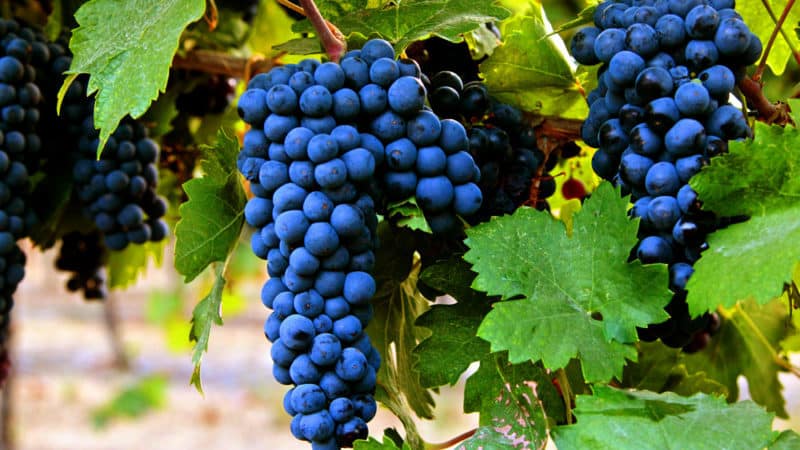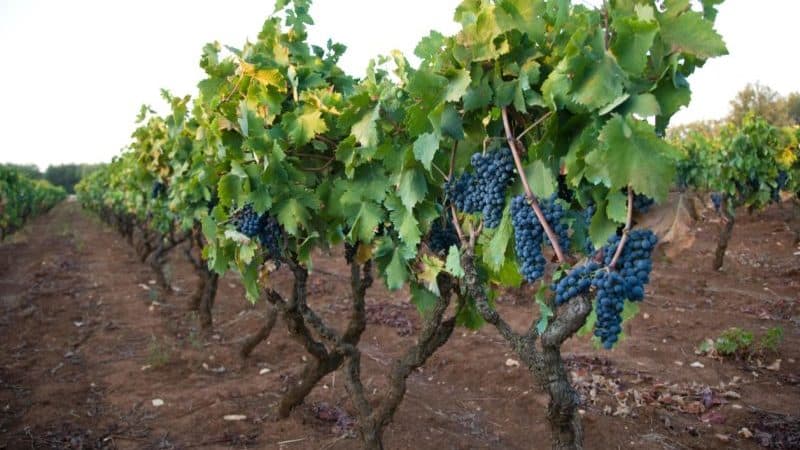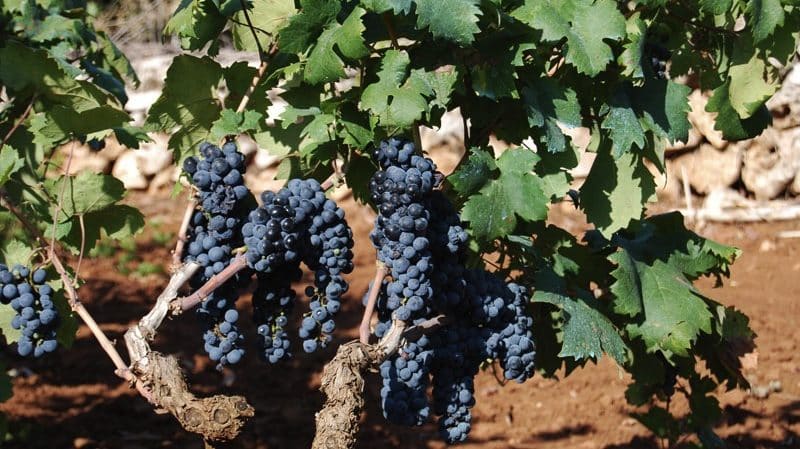Early ripening dark-skinned grape variety "Primitivo"
The Primitivo grape variety is used to produce sweet and semi-sweet red wines with a tart, astringent aftertaste. Berries with a high level of sugar content produce wine with a strength of 14-18%. The aroma is dominated by cherry, black cherry, berry, plum, pepper and vanilla notes. Read more about the variety and its distinctive characteristics in the article.
History of origin and description of the Primitivo grape variety
Disputes about the origin of this dark-skinned grape variety are still ongoing. “Primitivo” is an Italian name; the town of Gioia del Colle is considered the historical birthplace of this grape.. According to the Italians, the variety appeared here about two thousand years ago, but for some unknown reason it was forgotten, and at the end of the 18th century it experienced a rebirth.
Francesco Indellicati, a local clergyman, noticed that in the vineyards near the church, some vines were bearing fruit earlier than others, and named them Primitivo, which literally translates as “first” or “early”. From here the variety spread to Puglia and took root in Salento and Manduria.
At the end of the 60s of the twentieth century. Californian plant pathologist Austin Goin visited Apulia, a region in southeastern Italy. People call this territory the “heel” of the Apennine Peninsula. Here he noticed the amazing similarity of the local vine and wine from the Primitivo grape with the Californian Zinfandel variety. Returning to the USA, the scientist took several cuttings with him for research, which caused heated debate.
In the late 70s, isoenzyme analysis (DNA precursor) was carried out, showing the identity of the varieties. In 1993, Californian scientist Karol Meredith examined the genotypes of Zinfandel and Primitivo varieties, and confirmed that they were clones of the same variety.
Meanwhile, the Croats claim that the ancestor of the variety is the ancient Tribidrag grape, known since the 15th century. In the same 90s, Californian winemaker of Croatian origin Mike Grgic organized a search for grape samples suitable for study in Croatia. Thus, in 2001, it was possible to determine the genetic similarity with the varieties Crljenak Kastelanski and Pridibrag.

How did the vine get to the USA? According to one version, cuttings were brought to America in the 20s. XIX century from the Viennese imperial nursery. The customer was gardener George Gibbs (by the way, the Isabella grape variety was named after his wife). After arriving on the North American continent, the grapes were used to make dry and sweet red wines.
The journey of the Primitivo variety overseas played into the hands of its popularity. In the early 90s of the twentieth century, the grape was little known outside of Italy. In the USA, it received a new round of development and gained popularity all over the world. If earlier the Italians labeled bottles of Zinfandel wine, trying to popularize their products, now the Americans produce their wines under the name Primitivo.
Important. Despite the genetic identity, the different growing conditions of the grapes in Puglia and California led to mutations. Today Primitivo and Zinfandel are considered different varieties, although they have a common “progenitor”.
Characteristics of grapes
The Primitivo grape vine is tall. The clusters are medium in size and dense, which often leads to rotting of the berries.
The leaves are medium-sized, five-lobed, deeply cut, partially pubescent on the back side. The blades densely overlap each other.
Stepchildren ripen quickly and produce a second portion of fruit.
The variety is prone to peas - small berries ripen unevenly.
The fruits are small, round in shape, with a thick skin covered with wax. Color – dark purple. Petioles are short. The berries ripen unevenly. They contain many antioxidants, tannins, and vitamins.
Sugar content is high, depending on the growing region, reaching an average of 30%. Caloric content of 100 g of product is 60 kcal. To prepare wine with residual sugar, harvest fruits with a sugar content of at least 24%.
The aroma is dominated by notes of cherries, berries, plums, pepper and vanilla. Chocolate, floral and woody tones are clearly felt. The taste is rich, sweet, tart, with a pleasant sourness.
Reference. A waxy coating on the skin protects the berries from cracking in conditions of high air humidity.

Primitivo grapes are characterized by their tolerance to soil type and climatic conditions. If you follow the growing rules, you can collect about 10 kg of berries from 1 bush.
The variety is suitable for cultivation in the south of Russia and in regions with a temperate climate. The culture “loves” the sun and is not picky about the composition of the soil. For example, in their historical homeland in Puglia, gardeners have to chisel rocky soil before planting grapes, however, the stones perfectly protect the roots from drying out in the heat. The crop tolerates drought and is resistant to pests and diseases.
The flowering period begins in May and ends in June. The flowers open gradually - from 6.00 to 11.00 am. After complete opening of the stigma, they are capable of fertilization for 4-6 days.Fertilization takes 24 hours, after which the stage of ovary formation occurs.
A good harvest is possible; during the period of pollination and formation of ovaries there was a comfortable air temperature of +25...+30°C.
Advantages and disadvantages
Advantages of the Primitivo variety:
- high productivity;
- fruit sugar content;
- excellent taste and aroma;
- unpretentiousness to soil composition and climate;
- drought resistance.
Flaws:
- peas;
- demands on lighting;
- Dense bunches are prone to rotting.

Wine from grape variety
Primitivo grapes are used to produce dark, tannic, dark grapes with a rich flavor and a fruity-floral finish. A classic wine – fortified, with a high tannin content, a pronounced aroma and rich color.
In Manduria, the strength of liqueur wines reaches 18%, table wines - 14%.
The distinctive features of Primitivo wines are refined, fruity red wines with notes of Mediterranean herbs. Grapes accumulate a lot of sugar under the southern sun, so the wines are fortified and have a pleasant residual sweetness.

Famous wines:
- Primitivo di Manduria – fortified, sweet, almond-based, ideal for desserts.
- Primitivo di Manduria DOG Segretorosso – dry, violet-red, with notes of cherries, violets, strawberries, chocolate, juicy, velvety with a long aftertaste. It is served with meat, risotto and pasta.
- Byzantium I Primitivo di Manduria DOP – a rich garnet-red wine with the aroma of red fruits and plums. It is served with roasts, cheeses and first courses.
- Primitiv Astrale Rosso – red, dry, velvety and soft, with notes of blackberry and a long aftertaste, devoid of acidity, slightly tart. Serve with meat and pasta.
- Alchymia Primitivo Puglia IGT – red, semi-dry, with the aroma of cherries and cherries. The taste is velvety, enveloping, with a long aftertaste. Serve with grilled meats and meat appetizers.
Primitivo is combined with dark varieties Alicant Boucher and Shiraz. To produce rosé wine, it is combined with Riesling and white Muscat.
Grapes grown in temperate regions are used to produce a fortified dry wine with a balanced flavor, pronounced blackberry aroma and spicy residual notes.
Reference. Wines from the Primitivo variety are characterized by unlimited aging ability.
Planting seedlings
Grapes are planted in May, when the risk of return frosts is minimal - with seedlings with an open root system and cuttings. The site is chosen on the south side, with sufficient lighting.
To plant seedlings, in the fall the soil is dug up and a planting bed is formed with a depth and width of 70-80 cm. Drainage is placed at the bottom - 10 cm of broken brick or crushed stone. Soil is poured on top so that 0.5 m remains to the edges of the hole. Water the soil abundantly, wait until the water is completely absorbed and the soil subsides. Then the seedling is planted, spreading the roots evenly, and the hole is completely filled with soil.
The seedlings are shaded and watered daily. The soil is loosened and mulched with sawdust.
For planting cuttings specimens about 45 cm long are used. They are cut 14-15 days before flowering or at the beginning. The lower leaves are removed, an oblique cut is made and immersed in water at room temperature for 48 hours. After this, the section is dipped in liquid paraffin for 3-5 seconds and immersed in a growth stimulator (Epin) for 24 hours.
The pit is formed according to the principle of planting seedlings. A long stick is placed in the center to support the vine.A hole 0.5 m deep and 10 cm in diameter is formed nearby and the cutting is planted. The lower peephole should go 5 cm deep. Next, the hole is filled with soil and compacted. Water the ground, wait until the water is absorbed, and add a portion of moist soil, forming a hill of 15 cm.
Subtleties of further care

Proper care of the vine is a guarantee of a rich harvest. One of the most important agrotechnical procedures is pruning. Grapes direct nutrients mainly to the upper shoots. Therefore, the lower eyes lag behind in development and often do not produce young shoots.
Spring pruning performed in regions with a temperate climate, autumn - in warm areas, 20 days after the leaves fall.
In the spring, the procedure is carried out from the moment the sap flows - the sap promotes the healing of damage. If the moment is missed, remove old shoots and excess young ones.
To shape the bush, pluck out the extra eyes in the ash. The instrument is sharpened and disinfected in a solution of potassium permanganate. Young vines are cut with pruning shears, old ones with a saw. The cut is formed smooth and even, without cracks or splits.
In additional feeding the Primitivo variety does not need. However, on fertilized soils the vine grows better and faster, bears fruit abundantly and does not get sick. A solution of mullein (1:10) is used as foliar feeding; root feeding is 60 g of superphosphate, 40 g of potassium sulfate. And ready-made mineral complexes are best suited: “Master”, “Plantafol”, “Aquarin”, “Novofert”.
For protection, Azofos, copper sulfate, Quadris, Cumulus, and colloidal sulfur are used. From ticks use acaricides. Antifungal treatment is carried out in the summer with “Ridomil” or “Topaz” as the berries reach the size of a pea.Fungicides are also used in mid-summer, and iron sulfate in the fall.
Disease and pest control
The Primitivo variety is resistant to most fungal diseases. To protect against powdery mildew and peronosporosis, use “Quadris”, “Azofos”, “Cumulus”, colloidal sulfur once before flowering.
To prevent the spread of felt mite, planting process 3% solution of copper sulfate before flowering.
Harvest and storage

Harvesting begins in August, choosing a dry, sunny day. Berries that have reached technical ripeness can be left on the vine, but in rainy weather it is recommended to harvest the crop. To prevent rotting, the bunches are periodically thinned out.
The bunch is supported from below and cut with pruning shears next to the shoot. It is important to preserve the waxy coating on the berries. It is he who contributes to long-term crop storage. Rotten and dry, unripe and overripe berries are carefully removed.
The bottom of the wooden boxes is lined with newspaper, and the grapes are stacked with straw or paper, with the combs facing upward. The container is placed in a cool, dry place, periodically checking the condition of the crop.
For storage grapes are used in barrels with a volume of 10-15 kg. A layer of dry cork powder is poured onto the bottom and the bunches are laid in layers. The containers are placed in a dry and cool room. This method keeps grapes fresh for up to six months.
The optimal air temperature is 0...+8 °C, humidity – 65-70%. The room is pre-ventilated, general cleaning is carried out and the walls are whitewashed with lime. To eliminate excess dampness, lumps of quicklime are placed in the corners.
When fungus appears on the walls, the room is fumigated with sulfur or a sulfur wick.
When the air temperature rises, the cellar is ventilated; when it drops, electric heaters are installed.
Conclusion
The Primitivo grape variety and its analog Zinfandel have an interesting history of origin. The Italians are confident that its homeland is southern Apulia, in the USA it has long been considered “the most American variety,” and the Croatians claim that its ancestor is the ancient variety Tribidrag. Despite the unclear pedigree, wines from this grape are popular all over the world. Fortified, dry and semi-sweet, with a rich aroma and tart taste, they perfectly complement meat, pasta, risotto and desserts.
The plant is undemanding to the type of soil and growing conditions, rarely gets sick, but prefers areas with sufficient sunlight.